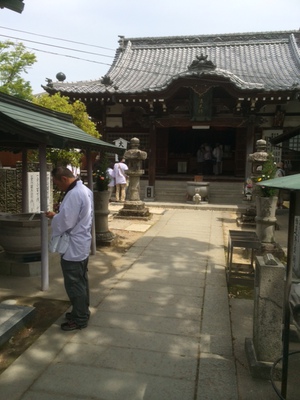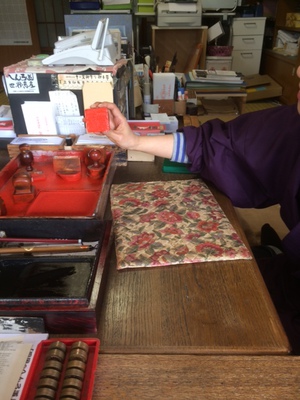Japanese Pilgrimage in Kagawa
2014年05月19日
The pilgrims’ route, or ‘henro’ pilgrimage in the Japanese island of Shikoku is and arduous walk of some 1,200 km taking anywhere between one or even two months to complete. The 88 temples of the Shingon or esoteric school of Buddhism dotted around this island and founded by the much-loved ‘Kukai’ as he is popularly called, or Kobo Daishi is becoming a world-class attraction.


The purpose of the pilgrimage taken by the faithful can be for any number of reasons; asceticism, healing, salvation, atonement & repentance. Or even just general wellbeing and exercise. It all depends upon the depth of belief and commitment to the faith. Stories of miraculous healings are legion. So are the devotees who make this journey a focal point of spiritual life especially towards the end of it. I’d like to think that one day I’ll do it myself as a few friends have already.


The circumambulation by foot around the island is expected of believers at least once in their lifetime but these days most undertake a bus trip instead of austerities on foot. A few ride bicycles, some even do the pilgrimage by taxi.


In these last twenty years or so, there have been any number if books about this pilgrimage and sad to say, they are pretty much all knock offs for profits & sales by people without much deep knowledge of what this is all about. I suggest reading the dated but beautiful book by Oliver Statler ‘Japanese Pilgrimage’ as it’s the standard by which all the others can be judged.


Statler’s book is the best and I can’t stress this enough particularly after reading a couple of the others. It will give you a deeper understanding of what is going on as will the book ‘Kukai Major Works’ by Yoshihito Hakeda (translated into English) The beloved Kobo Daishi Kukai the founder of Shingon buddhism, saint, miracle worker, engineer, is by far the most influential force in Japanese religious and societal beliefs. Yet sadly most of us in the west have never heard of him.


I took these photos at the 83 Ichiyomiyaji temple on the outskirts of Takamatsu at a town named Enza and we can see pilgrims in their traditional white clothes. The same ones many will wear to be cremated. The stamps are from the temples in official recognition they have travelled the route and the ink writings on the clothes are religious formulae of the faith.


Other bloggers in Takamatsu of interest:
http://cathy.ashita-sanuki.jp
http://ogijima.com
http://ww8.tiki.ne.jp/~tmath/home/
Where we are:
http://wikitravel.org/en/Takamatsu
http://www.city.takamatsu.kagawa.jp/english/
http://www.my-kagawa.jp/special/visitor/kanko/index.htm
http://www.i-pal.or.jp/profile/topics/kagawas-welcome-card.html


The purpose of the pilgrimage taken by the faithful can be for any number of reasons; asceticism, healing, salvation, atonement & repentance. Or even just general wellbeing and exercise. It all depends upon the depth of belief and commitment to the faith. Stories of miraculous healings are legion. So are the devotees who make this journey a focal point of spiritual life especially towards the end of it. I’d like to think that one day I’ll do it myself as a few friends have already.


The circumambulation by foot around the island is expected of believers at least once in their lifetime but these days most undertake a bus trip instead of austerities on foot. A few ride bicycles, some even do the pilgrimage by taxi.
In these last twenty years or so, there have been any number if books about this pilgrimage and sad to say, they are pretty much all knock offs for profits & sales by people without much deep knowledge of what this is all about. I suggest reading the dated but beautiful book by Oliver Statler ‘Japanese Pilgrimage’ as it’s the standard by which all the others can be judged.


Statler’s book is the best and I can’t stress this enough particularly after reading a couple of the others. It will give you a deeper understanding of what is going on as will the book ‘Kukai Major Works’ by Yoshihito Hakeda (translated into English) The beloved Kobo Daishi Kukai the founder of Shingon buddhism, saint, miracle worker, engineer, is by far the most influential force in Japanese religious and societal beliefs. Yet sadly most of us in the west have never heard of him.

I took these photos at the 83 Ichiyomiyaji temple on the outskirts of Takamatsu at a town named Enza and we can see pilgrims in their traditional white clothes. The same ones many will wear to be cremated. The stamps are from the temples in official recognition they have travelled the route and the ink writings on the clothes are religious formulae of the faith.
Other bloggers in Takamatsu of interest:
http://cathy.ashita-sanuki.jp
http://ogijima.com
http://ww8.tiki.ne.jp/~tmath/home/
Where we are:
http://wikitravel.org/en/Takamatsu
http://www.city.takamatsu.kagawa.jp/english/
http://www.my-kagawa.jp/special/visitor/kanko/index.htm
http://www.i-pal.or.jp/profile/topics/kagawas-welcome-card.html
Posted by pat at
23:38




